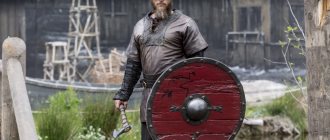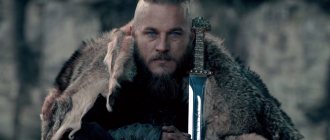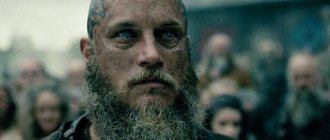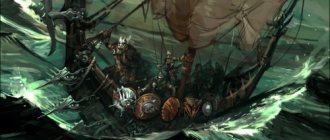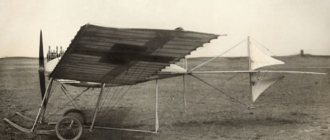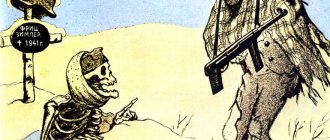Who said that nature rests on the offspring of famous fathers? The sons of the legendary Danish king Lodbrok may well argue with this statement. In terms of raids and military victories, the heirs were at least as good as their bloodthirsty father, and often surpassed him.
Ragnar Lothbrok, or Ragnar Leather Pants, lived in the first half of the 9th century, traded in sea robbery and was considered one of the influential leaders of Denmark. There is little reliable information about him, and most of what we know comes from heroic sagas.
Why was Ragnar called Lodbrok?
You can learn about the biography of the Viking Ragnar from the Scandinavian sagas. He received the nickname “Lodbrok” (which means leather pants) either in childhood or after his first marriage.
- The first legend tells that Ragnar was hunting in the forest as a child and accidentally fell into a hunting hole that the Vikings dug for a large animal. A lot of poisonous snakes accumulated in this pit, which immediately attacked the future Viking king. This could be the end of Ragnar's life story, if not for the thick leather pants. The snakes could not bite through them and the future “sea king” remained alive;
- According to the second legend, Ragnar received his nickname thanks to the care of his wife. It was she who sewed “magic” leather pants for him as an amulet. Most likely, the pants were made of thick hide with wool, otherwise the Vikings would not have attached such importance to this detail of their leader’s clothing. The thick skin perfectly protected against glancing blows from cold weapons, so Ragnar’s wife was right in calling it an amulet against injuries.
Scholarly linguists adhere to other theories regarding the origin of the nickname of this legendary or historical character:
- Some believe that the Vikings, when they gave the nickname "Londbrok", meant the dark green color of the pants;
- Others believe that this nickname has nothing to do with clothing at all and comes from a corruption of the name of the river Lodbrik, which translates as a stream of hatred;
- Another scientist believes that the Icelanders gave the king his nickname and it is derived from the word “leodbroga”, which means “frightening people”;
- According to another version, Ragnar went into battle under a banner with the image of the raven of the god Odin. His nickname was made up of two words, which together are translated as “Fateful” (lod - fate, brog - banner).
Clive Standen (Rollo)
TV series "Vikings": actor Clive Standen as Rollo |
fb.ru Rollo, Ragnar's brother, is constantly torn between family affection and betrayal. Believes that he is “in the shadow” of Ragnar. Later he becomes Duke of Normandy, having married the Frankish princess Gisla, and defends Paris from his own Viking relatives on the side of their opponents the Franks.
Clive Standen played the role of the knight Sir Gawain in the TV series Camelot, which is based on the legends of King Arthur. In 2008, the actor appeared in three episodes of the series Doctor Who. Currently playing the lead role in Luc Besson's spy series "Taken" about the adventures of CIA agents.
Biography
There are no reliable sources confirming the existence of Ragnar. Basically, the details of his life and activities are known from the Scandinavian sagas, which tell how Ragnar traded in raids and sea robbery.
Ragnar Lothbrok is considered the son of the 8th century (after 770) king of Denmark, Sigurd the Ring, who also came from the Yngling family. Sigurd the Ring is known as a superb military leader who was victorious in one of the bloodiest battles recorded in the sagas, over Harald Battletooth at the Battle of Bravellir in East Gautland. Sigurd the Ring ruled the Danish state until his death.
Ragnar Lothbrok is the legendary ruler of Sweden and Denmark, a famous conqueror, an invincible and skilled warrior in battle. He became an influential jarl by 845, which makes him a contemporary of Rurik (Novgorod prince from 862 (d. 879)). Legends say that Ragnar constantly strived for new conquests and heroic deeds, fearing that his sons could eclipse his glory. Most likely, if this king really existed, he carried out raids between 835 and 865 AD. In addition to being a ruler, Ragnar was known as a military leader, an adventurer, an adventurer who raided other countries, and also engaged in sea robbery. In Scandinavia he is considered a true national hero. Ragnar was a pagan. Moreover, he considered himself a direct descendant of the god Odin (if we resort to Slavic analogies and comparisons of gods, then Odin is similar in many ways to our Veles).
Hero of the sagas
The Scandinavian sagas, the main character of which is Ragnar Lothbrok, tell about his campaigns, raids on foreign lands and sea robberies. He is credited with many campaigns of conquest that were very successful. One of his most famous campaigns is still celebrated and considered a holiday - March 28, “Ragnar Lothbrok's Day.” The holiday of Ragnar Lothbrok, at which toasts are made in honor of Ragnar, songs about the famous king are sung, sagas are read and various public events are held, is considered a symbol of bravery and courage. On March 28, 845, Ragnar Lothbrok attacked France and captured Paris. Legends say that for this campaign Ragnar led 120 ships containing 5,000 warriors. The ships sailed up the Seine River and captured the capital of France. The king then was Charles the Bald, who admitted defeat, but he still managed to come to an agreement with the main Viking Ragnar, to whom he paid 7,000 pounds of silver. In return, Ragnar promised not to touch Paris and kept his word, but upon returning home, he plundered all the French lands he crossed. In one of the prayers of the French monks of his time, the following phrase appeared: “God deliver us from the fury of the Normans!”
Death
Ragnar Lothbrok died in 865. During a military campaign in Great Britain, his ship ran aground. This happened in Northumbria in the north of England. Here he was attacked by English troops. As a result, Ragnar and his Vikings were defeated. Ragnar was captured. He was brought to King Ell II, who ordered him to be thrown into a pit with poisonous snakes, where he died from numerous bites. Judging by the legend, Ragnar’s last words were: “How my dear piglets would grunt if they knew what it’s like for me, the old boar!” With these words, he hinted to the king that his sons would avenge their father's death.
Promise
Ragnar's promise came true. The sons, including Ivar the Boneless, Bjorn Ironside and others, avenged their father's execution in 867. The sons were especially furious by the fact that Ragnar died in captivity from snake bites, and not, as befits a great warrior, in battle. With their army, they invaded England, defeated the English troops, captured King Ella and executed him, subjecting him to cruel torture and torment. After this, kingdoms such as Northumbria, Mercia, and eastern England were plundered. This event is known as the Danish conquest of the island. It ended in 871, when the descendants of Ragnar and their troops were defeated by Alfred of Wessex.
Wives and children
According to the Ynglinga Saga, Ragnar had three wives. The first is Lagertha (Lazgertha), who was a shieldmaiden (female warrior). Lodbrok was able to take her as his wife only after he passed the test, fighting first with a wolf and then with a bear. She bore him a son and two daughters, but they were not destined to play a significant role in the history of Scandinavia. According to legend, the gods sent signs to Ragnar, setting first dogs and then a bear on him. This became the reason for the king to divorce Lagertha and marry Tora, the daughter of Earl Herred. The second wife gave birth to Lodbrok three more children - two sons and a daughter, but he also separated from her. The third wife, Aslaug, came from a family whose history matched that of Lodbrok himself. She was the daughter of Sigurd himself, the hero who killed the dragon Fafnir. From this marriage Lodbrok had five children - Sigurd the Snake-in-the-Eye, Bjorn Ironside, Ivar the Boneless, Hvitserk and Ragnhild.
Historians who consider Ragnar Lothbrok to be a real historical figure, as well as those who believe in the existence of a certain character who later became the prototype for these legends, suggest that he had at least eleven children from official marriages. Some of them marked the beginning of the Danish conquest of England. At the same time, many scientists agree that Ragnar Lothbrok was very prolific and disdainful of the concepts of marital fidelity. Therefore, in reality, he had many bastards, not only in Denmark, but throughout Scandinavia. This is confirmed by the story of how Ragnar, during one of his campaigns, changed into a woman’s dress and visited the daughter of a local peasant. Being like a woman and, in general, any hint of similarity with the weaker sex was considered a great shame for a Viking, so historians treat this legend as a metaphor for the fact that for the sake of a night with the woman he liked, Ragnar could neglect any laws and moral norms. Apparently, he treated marriage only as a means of increasing his social status - in fact, like most of his contemporaries.
Interesting fact: The most famous descendant of Ragnar Lothbrok is considered to be Sigurd the Snake-in-the-Eye. Sigurd's grandson Harald I became the first autocrat of Norway. Sigurd's nickname is usually explained by a congenital defect in the pupil, which was shaped like a snake or dragon, but modern historians still insist on the version that he was named Snake-Eyed because of his piercing gaze, which was a family trait of the Lothbroks
Linus Roache (King Egbert)
TV series "Vikings": actor Linus Roache as King Egbert |
fishki.net King Egbert is the ruler of the Kingdom of Wessex in Britain. A cunning politician who prefers to get his way through intrigue and negotiations. He offered the Vikings land in exchange for service and participation in the war of the British kingdoms on the side of Egbert himself and his allies. Egbert's men, with the king's permission, destroy the Viking settlement in Wessex as soon as the opportunity arises.
Linus Roache is an English actor who starred in the TV series Law & Order as Michael Cutter, first assistant commander and then chief of the ADA Bureau. In 2014, he appeared in one of the episodes of the series “The Blacklist”.
Three directions of Viking expansion
Three directions of Viking expansion can be distinguished. Norwegians were drawn to the North Atlantic, to the north of the British Isles, to Iceland and further north. The Danes inspired fear mainly in Central and Western Europe. And the Swedes were looking for profit in the East. But they had one thing in common - the legendary dragon ship and centuries of experience in surviving in any conditions.
Life in the Arctic Circle was a difficult experience. Since the scanty vegetation did not allow them to fill their stomachs, people depended on fishing, they went into the raging sea, often in the dark, sometimes the shore was not visible. When, finally, shipbuilding and navigation reached a level that allowed them to freely navigate the sea, they became ready for contacts with the world.
For a long time, the reason for the Viking expansion was considered to be population growth. Scandinavia was too small for two million people, and, moreover, according to the principle of seniority, only the oldest claimant to the inheritance received property, and the remaining men had to look for other occupations.
But today, researchers believe rather that the Vikings raided not out of necessity, but out of sober calculation. In the constant struggle with their neighbors, in the pragmatic handling of difficult living conditions, they had enough experience, which they turned into a new entrepreneurial model. Warfare and navigation were not only more profitable than agriculture, but also gave social prestige.
The main campaigns of Ragnar and his sons
Scourge of God
In 845, many Vikings considered Ragnar a successful sailor and were glad to go on a campaign with him. Therefore, without much effort, the king gathered 5 thousand Vikings on 120 ships to attack the West Frankish kingdom.
Lodbrok's closest ally in the campaign was the cruel and treacherous King Hasting. Ragnar trusted him so much that he even made his own son Bjorn, nicknamed Ironside, his mentor.
When the Vikings reached Frankish lands, they split their fleet into two with two commanders: Lodbrok and Hasting. Ragnar and his ships entered the Seine, and his comrade entered the Loire.
Hasting and his warriors conquered Nantes. The brutal Vikings burst into the city and killed everyone, regardless of age and stature, plundered and burned the church.
Ragnar was not far behind. He destroyed Rouen, the Saint-Ouen monastery, and the Jumièges monastery. The Fontenelle monastery paid the raider a huge ransom.
To Paris
Having joined forces in March 845, the leaders rushed to Paris. Seeing the dakkars sliding along the Seine, the watchmen sent a messenger to King Charles II the Bald.
But luck was with the northerners. The king of the Franks decided to prevent the Vikings from landing on land: he divided his army and placed it on both sides of the river. But the invaders managed to secretly land on the shore. One of the halves of the French army faced the full might of the northerners and lost the battle.
In order to frighten the second half of the French army, Ragnar ordered 111 prisoners to be hanged on an island in the middle of the Seine. This act achieved its goal, the Franks retreated and Lodbrok entered Paris on March 28 as a winner. Charles II paid 7 thousand pounds of silver (a huge sum at that time) so that the city would not be destroyed and the inhabitants would not be killed. In turn, Ragnar swore by his sword and Odin to leave the Franks alone. The invaders set off on their way back with all ransoms for prisoners and indemnities.
It was easy for Ragnar to break his vows and return to Paris again to demand more. But dysentery struck the Vikings, which saved the townspeople. The French lands of the Lower Seine were less fortunate: the northerners, who had come to their senses before sailing, devastated them to their fullest, thereby still breaking their oath.
Revenge for father
20 years later, in old age, Ragnar decided to plunder Britain. Northumbria, one of the seven island kingdoms, became a victim of the raid. But the Vikings were repulsed. The raiders were killed, and the wounded Ragnar was captured.
Lodbrok faced the execution prepared by King Ella II: death in a deep well with poisonous snakes. The famous leather trousers, a kind of talisman, protected the king’s legs, but one bite hit him in the face.
Lodbrok's sons were furious when their father's last words were told to them: “The piglets will grunt when they find out how the old boar died.” Particularly infuriating was the fact that Ragnar, who did not die in battle, found the entrance to Valhalla closed.
Historians, in principle, do not dispute the death of Ragnar Lothbrok as a result of an unsuccessful raid on Northumbria, however, in their opinion, in 865, as a result of a navigation error, his ship ran aground. Therefore, it was not difficult for the troops defending Northumbria to defeat the raiders from the north, and, having captured their leader, put him to death. Most researchers doubt that he died exactly as they say in the saga; the poetry of his dying speeches is also questioned. Perhaps they were added later, when his “pigs” really “grunted.”
After the news of their father's death, Ivar the Boneless and Bjorn Ironside were filled with anger due to the fact that their father was executed as a criminal and thus prevented from going to Valhalla after his death. They enlisted the support of several more brothers and assembled an army of thousands. In 867, the army went to Britain. Having captured Northumbria and gotten even with Ella II, they moved on and put most of England to fire and sword. This went down in history as the Great Pagan Army (Great Danish Army). Although skeptics do not dispute the fact that a large number of Vikings attacked Britain in the second half of the 9th century, they do not believe that the reason for the invasion of such a large army of northerners was revenge for Ragnar Lothbrok. Most likely, this was just an excuse, using which the sons of Ragnar were able to gather a large army to seize new lands.
TV series "Vikings"
Perhaps the most popular on-screen incarnation of Ragnar Lothbrok is Michael Hirst's Vikings on the History Channel. Ragnar Lothbrok is the main character of the series (his role was played by Australian actor Travis Fimmel). In the first season, viewers are introduced to an ambitious and intelligent Viking, and at the end of the series, Ragnar is already the king of all Denmark and the menace of the French and British kings. However, according to Danish sources written by Saxo Grammaticus in the 11th century, Ragnar Lothbrok was the son of Sigurd the Ring, king of Denmark and Sweden. So, in reality, Ragnar became king at the age of 15 - his father chose him as governor.
Ragnar's story was adapted and changed for broadcast. For example, in the series, Ragnar has only two wives - Lagertha and Aslaug, and besides, in the series, Ragnar has significantly fewer children than he actually had. Also in the series, a lot of attention is paid to his wife Lagertha, who was also a warrior - such women participated in battle along with the Vikings.
Writer and showrunner Michael Hirst also detailed Ragnar's early conquests - he studied the Norse sagas and other sources, but, like any series, came up with several characters who influenced the course of history in the series (although the story does not say anything about, for example, the monk Æthelstan, to whom Ragnar was very attached). The creators of the series also played on the theme of religion. It is known that Ragnar was a pagan, but in the 9th century Christianity had already penetrated into many territories as an official religion, and Ragnar went on campaigns against France and England, which were already Christian at that time. Hirst beat the gap in the annals when Ragnar is not mentioned at all. At this time, the hero Ragnar was “sent” on a journey, and attention was paid to his growing sons, about whom the peoples of Denmark and Sweden also wrote their own saga.
The death of Ragnar in the series is an important transitional event; it marked the transfer of power in Denmark and the ascension of his son Bjorn Ironside to the throne.
The Vikings practiced group sex and did not condemn homosexual relationships.
This is another nod from the screenwriter towards minorities. There is no confirmed data about the ease of sharing a legal wife with everyone, the cohabitation of women and men with people of the same sex, which would not be condemned by society.
And if some hints of male homosexuality, usually within the framework of violence against a rival, can still be found, then everything else is fiction and an attempt to imitate “Game of Thrones”. In terms of sexual life, all Germanic peoples were distinguished by great restraint. But this did not stop them from having several wives, concubines, and also sexually exploiting slaves.
Memory and recognition
Ragnar Lothbrok's Day is celebrated in the Scandinavian countries on March 28, because it was on this day in 845 that Ragnar's troops besieged Paris. On this day, a toast is made in honor of Ragnar and his Saga is read. However, the celebration of this day today in no way indicates an aggressive attitude or glorification of cruelty. On this day, Scandinavians pay tribute to their history.
The image of Ragnar Lothbrok can be found not only on the pages of Scandinavian sagas and chronicles. The legendary Viking is described in the novels “The Hammer and the Cross” by Harry Harrison, “Interstellar Wanderer” by Jack London, “Viking” by Edison Marshall and the novel of the same name by Alexander Mazin, “Two Kings” by Maria Semenova.
The image of the fearless Viking Ragnar is especially popular in video games - Crusader Kings II, the Civilization series Sid Meier's Civilization III: Play the World and Sid Meier's Civilization IV: Warlords, in the games Mount & Blade and Mount & Blade: Warband-Viking Conquest, and also Rune.
Today, the story of Ragnar Lothbrok, like other similar personalities, continues to live on. Moreover, this heritage continues to acquire legends and receives ever new interpretations. Numerous books, films, and computer games featuring semi-legendary characters continue the centuries-old tradition of myth-making, adding new colors and plot twists to existing stories, trying to look at their exploits from a different perspective.
